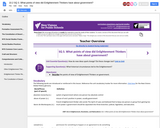
New Visions: Intro to Enlightenment
- Subject:
- History
- World History
- Material Type:
- Primary Source
- Provider:
- New Visions for Public Schools
- Date Added:
- 08/29/2018

New Visions: Intro to Enlightenment
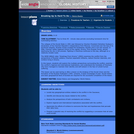
The collapse of the Soviet State in 1991 was followed by Chechen President Dzhokhar Dudayev's declaration of the Chechen Republic's independence from Moscow. Concerned over the loss of its territorial integrity, Russian troops invaded the breakaway republic and a civil war ensued. In l996, Chechen rebels regained control of the capital, Grozny, from Russian forces, almost destroying the city in the process. Fighting in Chechnya continues to this day, although on a relatively smaller scale. The WIDE ANGLE video 'Greetings From Grozny' (2002) examines the conflict from the perspectives of Russian soldiers, Chechen separatist militants, radical Chechen Islamists, and civilians living in Grozny.In this lesson, students will explore the multiple perspectives surrounding the conflict, examine the conflict's regional and international implications, and understand the mindsets of Chechens who have managed to maintain their identity and self-esteem in the face of untold human suffering. This lesson can be used during or after a lesson on the breakup of the Soviet Union and the formation of the Russian Federation (1991- present). A basic knowledge of post- Soviet history and basic geographical facts of Eurasia are required for the successful completion of the lesson.
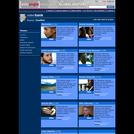
This is a collection of downloadable video clips on the theme of Conflict, with guiding questions for students. Clips are drawn from the following PBS WIDE ANGLE documentaries: "Greetings from Grozny" (2002), "Ladies First" (2004), "Suicide Bombers" (2004).
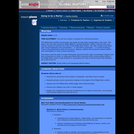
The Middle East conflict and terrorism are issues we hear about almost daily in the news. This lesson will use video clips from WIDE ANGLE's 'Suicide Bombers' (2004), Internet sites, and primary sources to examine the roots of the Middle East conflict. The video contains interviews with young Palestinians who participated -- or intended to participate -- in suicide bombings. These young Palestinians share the personal, religious, political and emotional reasons behind their participation in these suicide operations. This lesson could be used to review information about the three major monotheistic religions and their connections to Israel, to relate post-World War II policies to the current political state of the Middle East, and/or to get students to understand the roots of the terrorism that threatens the world we live in.
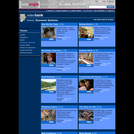
This is a collection of downloadable video clips on the theme of Economic Systems, with guiding questions for students. Clips are drawn from the following PBS WIDE ANGLE documentaries: "To Have and Have Not" (2002), "A State of Mind" (2003), "Ladies First" (2004), "1-800-INDIA" (2005), "Border Jumpers" (2005).
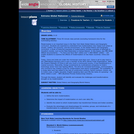
Modernization is an important issue in the New York State Global History and Geography curriculum. Students are expected to understand how modernization may impact such areas as society, politics, the economy, and the environment. In the Global History and Geography curriculum, a study of historical examples of modernization includes examples of attempts to transform society, such as the Meiji Restoration or Kemal Ataturk. In this lesson, two PBS WIDE ANGLE documentaries -- "To Have and Have Not" (2002) and "1-800-INDIA" (2005) -- will enable students to examine the effects of modernization on two Asian countries: China and India.
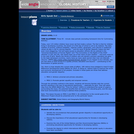
Today, over 115 million children have never set foot inside a school. The fact is that for children living in developing countries, the dream of a first day of school is yet to be realized. The daily realities of poverty, political instability, regional conflict, geography, and cultural or traditional values all play a role to varying degrees -- and the issue of gender disparity makes this fact even more staggering. Full and equal access to education (Article 26) as outlined in the 'Universal Declaration of Human Rights' and 'The Convention on the Rights of the Child' (Articles 2,3,28, and 29), has clearly been out of the reach of poor children -- and even more so in the case of girls. Nearly two-thirds of children who are denied a primary education are girls. In the least developed countries, nearly twice as many adult women than men are illiterate. (Source: UNFPA http://www.unfpa.org/icpd/10/icpd_ed.htm) If you happen to be a female, you are less likely to have access to a quality primary education and beyond -- contributing to the feminization of global poverty. Yet, there is hope despite this current state of affairs. 189 nations have pledged to meet 8 major Millennium Development Goals (MDGs) by 2015. In doing so, nations hope to improve the social and economic development of all peoples. Included in these goals are those that address education and gender disparity: MDG 2: Achieve universal and primary education. MDG 3: Promote gender equality and empower women. Through the activities outlined in this lesson, students will become familiar with the current barriers standing in the way of educational opportunity -- especially for girls. They will watch clips from the WIDE ANGLE film 'Time for School' (2003) to understand the sense of urgency surrounding this issue, the potential benefits that can result from educating girls, and the ways that local communities are trying to address these problems. Note: This lesson focuses on MDG 2 and MDG 3. An introduction to the overall goals of the Millennium Project should be presented prior to this particular lesson.
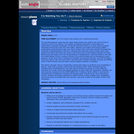
The post-Renaissance world saw the nation-state mature and confront the issue of how to control the lives of its citizens. Two models of political organization, democratic and authoritarian, gradually developed. During the twentieth century, as some nations granted individuals and groups more and more rights, ideology and modern technology enabled authoritarian governments to gain ever more control, until community interest dominated the individual and totalitarianism was born. Although Nazi Germany and the Soviet Union have passed into history and there are cracks in the total control of the People's Republic of China, North Korea still retains all of the characteristics of totalitarianism. Still technically at war with the United Nations Forces, it poses a threat to the world at large with its developing nuclear program. At the same time it continues to threaten its perceived enemies. Very few foreigners have been able to visit and record life in the Democratic People's Republic of Korea (the official name of North Korea), and the nation remains largely unknown to outsiders. This lesson will begin with an introductory activity that draws on students' prior knowledge to discuss, 'How does a society create social and political order?' After brainstorming the characteristics of totalitarianism, the class will be divided into groups to locate historical examples and create a Document Based Question to share with their classmates. Students will next examine excerpts from the WIDE ANGLE film 'A State of Mind' (2003) to see how the characteristics of totalitarian societies still operate today in North Korea. As a culminating activity, students will analyze editorials on North Korea's nuclear program from newspapers around the world, formulate their own opinions, and write a Letter to the Editor of their local newspaper.
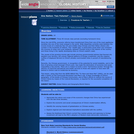
Since the mid-l970s, economic reforms have transformed China from one of the most egalitarian societies into one of the most unequal in the world. Wide disparities currently exist between the income levels of a relatively few rich and middle-class Chinese and their fellow citizens who number in the hundreds of millions. This "wealth gap" is particularly acute when one compares the incomes of urban and rural residents, between Chinese living in the interior of the country and those living in the rapidly developing cities on China's eastern coast.The causes of the growing income gap include previous governmental policies that favored city dwellers over farmers, the uneven regional patterns of foreign investment, and the massive outflow of displaced farmers to China's already overcrowded cities in pursuit of manufacturing jobs.Recently, the Chinese government, in recognition of the potential for social instability, and in the face of growing unrest amongst China's poor, has made the elimination of economic and social inequalities a top priority. Plans are in motion to build a more "harmonious society" through the delivery of improved educational and health services to those who appear to have been left behind in China's rush to modernize its economy.This lesson, using clips from the WIDE ANGLE film "To Have and Have Not" (2002), can be used after a lesson on the Communist Revolution and Mao's rule. A basic knowledge of China's geography, of the tenets of Chinese Communism, and of Mao's efforts to redirect the course of China's future by means of the Cultural Revolution, is required for the successful completion of the lesson.
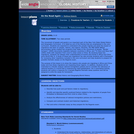
The movement of people and goods is an important part of the New York State Global History and Geography Curriculum. It is listed as one of the themes that are emphasized in the core curriculum. Students are expected to understand why people migrate and what the impact of migrations has been on people, nations, and regions. Recently, the PBS WIDE ANGLE documentary series created two programs that relate to the movement of people. 'Border Jumpers' (2005) documents migration between countries in Africa, and 'To Have and Have Not' (2002) deals with migration from rural to urban areas in China. By studying these two migrations, students can deepen their understanding of events and trends in Africa and China since World War II. A study of these two migrations can also provide students with a framework for reviewing other migrations included in the core curriculum and help students to prepare for possible thematic essays on the Regents exam. The purpose of this lesson is to show the reasons why people are migrating in Africa and China today and how these migrations are impacting those regions. In addition, students will be motivated to critically analyze national immigration policies and to consider the relevance of national borders in a world that is experiencing rapid globalization. As a culminating activity, students will outline a response for a sample Regents thematic essay question and will be assigned to write the essay for homework.
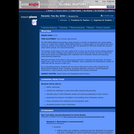
The PBS WIDE ANGLE documentary series analyzes a number of significant and current global issues. In 'Ladies First' (2004), WIDE ANGLE delivers a riveting report on the political and socio-economic success of the Rwandan women after the genocide of 1994 that divided the country's major ethnic groups, the Tutsi and the Hutu. The purpose of this lesson is to use 'Ladies First' to show not only that women working together can and did create a dialogue and a basis for trust among ethnic groups, but also to show how these same women are challenging their traditional role in Rwandan society and assuming unprecedented leadership. Although the basis of the lesson is the success of women in Rwanda post-genocide, the lesson begins with a clip from the movie HOTEL RWANDA, which establishes the devastating brutality of 1994 that left the country in utter ruin. As a Culminating Activity, students will use various Web sites to hone skills needed for the Global Studies Regents Exam, including: analyzing statistical, economic, and demographic information; a map exercise; and the interpretation of a primary document.
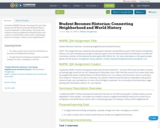
Created by NHPRC Teacher Participant/Creator John Ronzino for AP World and grade 10 Global History courses; Adaptable to other grades. The project has students research neighborhood/family history and connect to world history events, with a culminating project of creating a “history of the neighborhood”.

We will doggedly ask two questions in this class: “What is history?” and “How do you do it in 2010?” In pursuit of the answers, we will survey a variety of approaches to the past used by historians writing in the last several decades. We will examine how these historians conceive of their object of study, how they use primary sources as a basis for their accounts, how they structure the narrative and analytical discussion of their topic, and the advantages and limitations of their approaches.

This subject examines some of the many ways that contemporary historians interpret the past, as well as the multiple types of sources on which they rely for evidence. It is by no means an exhaustive survey, but the topics and readings have been chosen to give a sense of the diversity of work that is encompassed in the discipline of history.
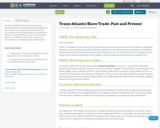
Created by NHPRC Teacher Participant/Creator Michael Mondello for Global History. This assignment asks students to use primary documents from the Transatlantic Slave Voyage Database to trace patterns between a selected African country and a select Latin American/ Caribbean country and to analyze the circumstances surrounding the Age of Exploration.

Created by NHPRC Teacher Participant/Creator Melissa Banks for her Global History; with modifications for English Language Learners. The assignment asks students to investigate their own immigration story, and to create a storybook that connect the to push-pull factors in their own immigration story to world history events.
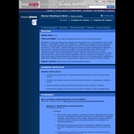
Worldwide, women are influencing businesses and economies on an unprecedented scale. WIDE ANGLE's '1-800-INDIA' (2005) and 'Pickles, Inc.' (2005) give us insight into two instances of economic and social shifts being wrought by the entry of women into local and international economies. In this lesson, students will begin by examining historic photographs to determine how economic roles for women have changed in the United States. They will then look at contemporary examples of women entering the workforce for the first time: in India's outsourcing sector; and in small business in Israel. They will explore how these women's entry into the economic sphere often involves negotiation and the overcoming of obstacles, but can bring about larger social and behavioral changes as well. As a Culminating Activity, students will apply the knowledge gained in this lesson toward a response to a Document-Based Question.